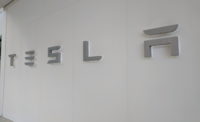Tesla Sees Major Gains in Solar Deployment, Slow Solar Roofs

Photo courtesy of Tesla.
The second quarter of 2022 proved to be one of the best for Tesla in four years regarding solar deployment, but its Solar Roof product isn’t leading the charge.
The latest earnings report from the automaker and energy company shows that it deployed 106 megawatts of solar in the last quarter, which is a 25% increase compared to the same time last year. It’s also a 120% increase from the first quarter, where only 48 megawatts were deployed.
“Although we continue to experience import delays beyond our control on certain solar components, we have expanded our supplier base to enable growth in this business,” the earnings report says. “Our solar installation team continues to improve installation efficiency, enabling higher volumes and stronger economics.”
Tesla doesn’t break down how much of the deployment is from solar panel retrofits or its Solar Roof product in the reports. Previously, Tesla CEO Elon Musk wanted the company to produce 1,000 new Solar Roofs per week by the end of 2019. According to documents obtained by Electrek, the company deployed 2.5 megawatts of Solar Roofs during the second quarter of 2022, which equates to 23 roofs per week.
The company has reportedly paused Solar Roof installations in nearly every market in the U.S., which Electrek states is likely due to supply issues causing a shortage of solar tiles. This was the case in March, where Musk said it was hard to predict 2022 “because we still have lingering supply chain issues globally.”
“The past few years have been quite a few force majeures, and it’s been kind of supply chain hell for several years,” Musk said during the Q2 2022 earnings call.
Tesla’s Solar Roof differs from other solar roofing products by using glass tiles with solar modules built into them. These tiles are installed on a roof in place of traditional shingles and solar panels, essentially becoming the roof itself. The product is in its third version, and the company has previous stated it has improved installation times. The Solar Roof was initially announced in 2016.
The earnings report also summarized energy storage deployment, which fell by 11% year over year in the second quarter to 1.1 gigawatt hours. Tesla states this is due to semiconductor challenges, which are impacting its energy business more than its automotive business.
“Demand for our storage products remains in excess of our ability to supply,” the earnings report says.
Looking for a reprint of this article?
From high-res PDFs to custom plaques, order your copy today!






